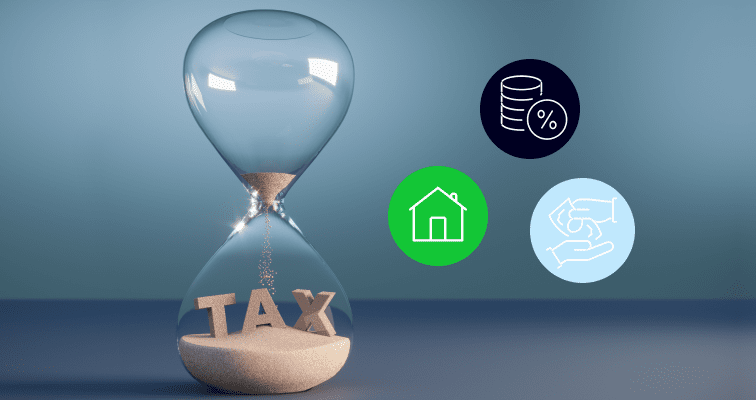User-friendly trading platforms simplify the process of investing, but when you sell financial assets, you may need to pay capital gains tax (CGT) on any returns. Find out how CGT works in Denmark, and what you need to know to protect your investments.
In Denmark, if you buy stocks, bonds, foreign currency, or hold cash in some types of savings accounts, you might have to pay capital gains tax on the income from those assets. Typically, this charge occurs when you sell those assets at a higher price than what you paid for them, but there are also occasions where you must pay CGT on positions that have not yet been liquidated.
There is a lot to consider, but this guide will help you to navigate the process seamlessly and possibly more cost-effectively. It explains what Danish CGT is, how to calculate it, and how you can ensure that you pay no more than the legal requirement.
What is capital gains tax (CGT)?

CGT is the payment you are obliged to make when you profit from buying and selling shares, property or other financial assets.
If you sell an asset at a price that is higher than what you paid for it, any returns could be liable for CGT.
In Denmark, holding some assets such as exchange-traded funds (ETFs) can generate CGT liabilities even if you do not sell the position. In such cases, a mark-to-market reading is taken to determine the difference in the notional value of this holding at the beginning and end of a tax year. If the value has increased, you might need to pay a percentage of this gain in the form of CGT.
While some banks, brokers and other financial institutions that hold your assets might withhold any CGT due on your account and pay it directly to the national tax office, it is your obligation to ensure that all of your CGT requirements are met, as incorrect reporting or underpayment of tax can result in fines and legal charges.
Tip: Developing a greater understanding of CGT can present ways of minimising your tax charges.
The amount of CGT you pay will depend on several factors and your personal situation. The rate can vary according to what types of assets you hold and how long you have held them. You may also want to consider any capital losses you have made when you sold an asset for a price lower than what you paid for it, as losses can be offset against capital gains on other trades.
What assets have capital gains tax?
Establishing if your investment activity might bring you within the scope of CGT starts with considering what capital assets you hold. While the below list is not exhaustive, it outlines some types of assets that are liable for CGT in Denmark:
- Stocks and shares
- Cryptoassets
- Bonds
- Foreign currency
- Some pension plans
- Interest
- Funds held in overseas accounts
- Dividends
- Rents
- Royalties
- Professional fees
- Annuities
- Alimony
- Real estate
- Foreign investments
- Some private (non-business) assets
There are also some investments that fall outside of the scope of CGT. It is important to do your own research to establish whether this is the case, but items that might be CGT-exempt in Denmark include:
- Furniture
- Art
- Jewellery
- Privately owned property that is deemed to comply with ‘parcelhusreglen’ regulations
If you need help establishing whether Danish CGT applies to you, it may be wise to request help from a specialist tax agent. They can ensure that you do not miss any CGT liabilities, file your returns correctly, and identify ways to minimise your CGT-burden.
How does CGT impact my other investments?

The most obvious trigger of a CGT event is the sale of a financial instrument such as shares, but you may still pay a CGT charge even if you don’t actively trade during the tax year, because some instruments incur CGT on their change in value, even if the holding is not liquidated.
The way that CGT impacts your portfolio may influence your overall approach to investing and result in you adjusting your strategy to make it more tax efficient.
For instance, you may decide to stagger the sale of a holding of shares over a period of years so that you use up your annual DKK2,000 personal tax allowance over several years. You may also decide to invest in instruments and investment vehicles that are CGT-exempt.
In countries where dividends are CGT-free, there is the option of holding a position long term and receiving a passive income while not crystallising any capital gains. This option does not apply to citizens of Denmark, as dividends are liable for CGT in the same way that capital gains are.
How do I calculate my CGT?
The method for calculating CGT depends on the nature of the transaction. In Denmark, the standard CGT rate is 42%, and a personal allowance of DKK2,000 exists for popular instruments such as stocks and bonds. Declare income gain or loss in your annual Danish tax return. If the profit or loss exceeds DKK2,000 for bonds, certain securities or gains due to exchange rate fluctuations, then CGT applies.
For instance, if you earned a return of DKK3,500 from selling shares in shipping giant A.P. Møller Maersk, your CGT would be DKK630 ((3,500 – 2,000) x 0.42).
For assets that are taxed annually, regardless of whether you sell them or not, the CGT calculation involves subtracting the notional value at the end of the year from the notional value at the start of the year.
If you hold investments outside of Denmark, including cash in foreign savings accounts, consider the fact that currency fluctuations also come into play. Even if the stock price remains unchanged, a CGT charge may occur if the foreign currency appreciates against the Danish krone.
Tip: The Danish Tax authority has an informative website that provides ‘golden source’ information on how the tax system works.
How can I minimise my CGT burden?

While you may not be able to avoid paying capital gains tax entirely, there are some approaches you can take to reduce the amount of tax you pay each financial year.
Take advantage of capital losses
Not all trades are winners, but in some instances, you can offset capital losses against your capital gains. There are rules and regulations that apply – for example, crypto losses can’t be offset, but losses on shares quoted on a regulated stock exchange can be offset against dividend and capital gains on other quoted shares in the same year.
Take a long-term view
Capital losses can, in some instances, be rolled over and netted off against capital gains in subsequent tax years. Some types of losses can even be carried forward for an unlimited period of time.
Speak to a professional
A tax agent who specialises in investment taxation will be able to establish if there are any ways that you can reduce your CGT. The details of the tax code can be confusing, and an experienced professional will be able to steer you towards sensible options for tax-minimisation and mitigate against the risk of you breaching the Danish tax code.
Final thoughts
Capital gains tax is an unavoidable part of the investment process in Denmark. It is crucial that you familiarise yourself with how Danish CGT works and understand your filing and payment obligations. Engaging the services of a tax professional can give you greater confidence and free up time for the important task of picking the best investments. After all, CGT is only paid on positions that show a profit!
Join eToro today and learn more about CGT, investing in shares and trading in general.
FAQs
- What is the FIFO principle?
-
FIFO, or ‘first-in, first-out’, is an accounting term that explains how CGT is calculated on complex portfolios. If you build a position in an asset over time by booking a number of different trades, then for CGT purposes, the gain posted when you start selling that position uses the difference between the price of your first sale and the price reported on the first buy trade. If you continue to sell your position, then when this first position is fully liquidated, you would move on to using the price on the second trade, and so on.
- Do I have to pay CGT to Denmark if I invest in assets outside of Denmark?
-
If you are subject to full tax liability in Denmark, then you must pay CGT on any investments bought overseas or held in foreign accounts. They are treated in a similar way to investments made within Denmark.
- What is the best way to track my investment transactions?
-
Your broker, bank, or whatever investment service provider you use should provide you with a full and detailed breakdown of your investment history. This will cover individual transactions and overall profit and loss. Some, but not all, brokers offer their clients additional services such as annual tax statements, which free up your time and allow you to focus on the task of choosing the right investments to buy.
This information is for educational purposes only and should not be taken as investment advice, personal recommendation, or an offer of, or solicitation to, buy or sell any financial instruments.
This material has been prepared without regard to any particular investment objectives or financial situation and has not been prepared in accordance with the legal and regulatory requirements to promote independent research. Not all of the financial instruments and services referred to are offered by eToro and any references to past performance of a financial instrument, index, or a packaged investment product are not, and should not be taken as, a reliable indicator of future results.
eToro makes no representation and assumes no liability as to the accuracy or completeness of the content of this guide. Make sure you understand the risks involved in trading before committing any capital. Never risk more than you are prepared to lose.


